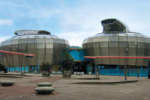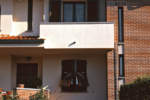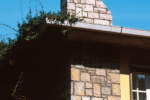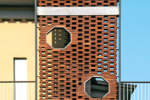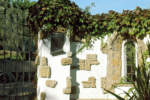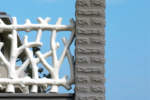In architecture, but also in creative fields more in general, from design to photography, from cinema to literature, the term simplicity generally has a positive connotation, with a value and charge of mysticism that evokes authenticity and truth (Mario Botta), the coherence of a cognitive process where the very same term indicates an individual’s ability to put together several elements and give them a synthesis and unity (Alberto Campo Baeza). In actual fact, in every creative activity, as opposed to natural elements, the idea of simplicity is not the starting point but the ultimate goal of every action, not the opposite of complexity but rather its solution, its overcoming. Literally, if the adjective simple means unitary, homogeneous, something which “excludes association with other elements in a composition” (De Voto Oli), and the noun simplicity “the typical characteristic of something made of a single element”, it is in the act of simplification that the verb seems better suited to describe simplicity as a typical trait of design, as an activity aimed at “rendering simple or simpler, eliminating elements of complication and difficulty” without a process which is intrinsically and indisputably complex. Consequently, some common nuances or meanings which associate simple with banal, with ingenuity, unpretentiousness, modesty and ease (as denunciated by Oliviero Toscani) have nothing to do with design and thus with creative activity, in which context simplicity is synonymous with elegance, sobriety, naturalness, the epilogue of a process where only some authors truly reach the goal, and thus essentiality. The unitary quality, and with it simplicity, is therefore the ultimate result of every synthesis, of every composition, to the point of demonstrating the unfeasibility of the reverse process, its opposite. Read in this key, it comes as no surprise that the term is invoked and considered essential also by authors who may, at a superficial glance, appear oriented towards highly complex results, as Patrick Schumacher underscores with regard to the architectures of Zaha Hadid, or Paolo Portoghesi as champion of a reflection and layering of history within design. To the architect the word simplicity therefore does not mean the renunciation of a complex elaboration that is the fruit of a cognitive investigation of numerous implications, but rather an author’s ability to capture, through an individual method based on architectural design, those salient aspects which rhetorically express, in a fragment - it may be a matter of the space, the surfaces, a material – that whole representing the variegated universe of elements and components involved in the making of every architecture. And, just like every treatise or writing, if it is true that architecture expresses and is in the final analysis a tale, then what really validates its efficiency is not the style or calligraphy but the message of that tale; a message which will be as strong and incisive as its deciphering and interpretation is simple and immediate. As a result, the complexity of an architectural design coincides with the initial data and elements, while its result, being an accomplished synthesis, cannot but prove to be simpler.

1. Olivo Barbieri
A useful concept of simplicity can be found in an old declaration of Nam June Paik: ”the more I work with television, the more I think of the Neolithic”.
2. Mario Botta
”simplicity = truth”.
3. Alberto Campo Baeza
Nefertiti’s Head on Simplicity
Simple simplicity.
When the Russian architect Konstantin Melnikov decided to build his own house, a fascinating white cylinder in Moscow, he wrote these harsh words: “As I had become my own boss, I begged Architecture to finally take off her marble dress, to wash the makeup off her face, to show herself as she is NAKED, like a young and graceful goddess. And as befits a true beauty, to renounce being agreeable and obliging” (Konstantin Melnikov. “Na Shchet doma”.1953. Melnikov archives ).
SIMPLE is ESSENTIAL it is not MINIMAL
SIMPLE is LOGICAL it is not CAPRICIOUS
SIMPLE is RATIONAL it is not RATIONALIST
“Clarity is the philosopher’s courtesy”, Ortega y Gasset.
SIMPLE is CLEAR it is not COMPLICATED SIMPLE is PUR it is not COLD
SIMPLE is DELICATE it is not BLAND
“Je pense l’Architecture, donc je suis un architecte”.
R. DESCARTES + ACB
SIMPLE is TRUE it is not FALSE
SIMPLE is HONEST it is not
a SWINDLER
SIMPLE is POETIC it is not PROSAIC
I have been trying for many years to create an Architecture that is essential, logical, rational, clear, pure, delicate, true, honest and poetic.
I reject Architecture that is minimal, capricious, rationalist, complicated, cold, bland, false, swindler and prosaic.“We are fed up with seeing those who pursue the Beauty, Goodness and Truth of things with additional ornaments; we know that the secret does not lie there. My unforgettable friend J.A. Coderch said that if we assume that the ultimate beauty is like
a wonderful bald head (for instance Nefertiti), then we must have torn it off, hair by hair, with the pain of every single tear, one by one. We must painfully pull the hairs off from our works, the ones that prevent us from attaining their simple, simple end”. This desire of Alejandro de la Sota could be a clear expression of this studied, simple simplicity.
4. Antonio Citterio
My concept of simplicity is something very complex, because something is never simple because of its form or function, the concept of simple is something holistic, it really contains more situations that make it simple. A simple object is almost always an object that it is easy to understand how to use. A hammer is a simple object, while a screwdriver is not. Take a design object like a lamp; you understand how to switch it on and off, whether it provides a beautiful light or not. A simple object is almost always timeless, it is something that lasts in time.
5. Felix Claus
Simplicity is for us both a strategy to control the execution of the project, as well as a principle of expression of its architecture. The decline of craftsmanship in the building process makes it a necessity for architects to control the actual physical result of their planning by making the design fool-proof in respect to execution. This requires a reduction of the project into a few simple elements to guarantee the perfect result. In a world that is more and more determined by quick visual satisfaction, architecture tends to service this demand by producing more and more flashy projects. We believe that a mature public space also requires simple generic buildings that serve their users. These productive buildings are uncomplicated easygoing personalities with strong character. These two interpretations of simplicity find their analogy in gastronomy. We prefer spending all our energy in cooking a really perfect simple dish every day (say spaghetti aglio-olio), controlling the quality of all ingredients, the preparation, the service and the cultural continuity that goes with it, over the trendy stress that comes with yet another seventeen course tasting menu. Like Mies said: I don’t want to be interesting, I want to be good. Simplicity is a virtue.
6. Nigel Coates
Simplicity is relative, perhaps overrated and sometimes deceptive. Compared with Nash’s Brighton Pavilion, William Morris’s Red House is minimal, and dare I say simple. In my own work I have always gone for a narrative approach that favours a rich palette of ideas and a density of meaning. Yet I avoid complication for the sake of it. Design is about getting things right according to your own judgment. At the beginning of a project I let my mind run wild, and pull references from as wide a variety of sources as possible. When I’ve got a feel for the narrative and volumetric vocabulary, I haul it in until it’s as simple and as clear as a theorem. Exercising restraint is the real skill, but you need to know how to create excess in order to constrain it. In my architecture I see the NCPM (National Centre for Popular Music in Sheffield) and its sister Powerhouse::uk (which was a temporary exhibition structure in Whitehall, London) as simplicity demonstrated. In both of these the four drums make an autonomous spatial statement as independent of context as possible. They have no features that suggest rooms behind the facades. The drums could as easily be industrial tanks as galleries. This gives them an other-world simplicity. Among objects I’ve designed, the Big Shoom bowl for Alessi is simplicity itself, at once a clear sign and mysterious in the effects of its curves. Both the NCPM and the bowl make use of stainless steel. Perhaps I equate simplicity with this one material.
7. Michele De Lucchi
Simplicity is a mental attitude which becomes very easy to understand if we consider the figure of the craftsman. The craftsman makes things one by one, dedicating himself to his work in the pursuit of an emotional gratification, on which basis he may earn a profit (Richard Sennett).
Today I associate the term simplicity with manual work and with an immediate comprehension of the organization of the manufacturing techniques. In the general increase of the complexity of the technological systems, simplicity, in the sense of an awareness of how things are made, is synthesis. Simplicity is the attitude we search most intently for, in order to rediscover Man. Learning means to make things simpler to our eyes. Thus a thing becomes surprising when it is surprisingly simple.
8. Carlos Ferrater
- x - = +
less x less equal more
9. Massimiliano Fuksas
”Less Aesthetics more ethics”. Could this be of help to a design and an utopia aimed at a better future?
10. Luca Molinari
”Far from the eye-catching splendours of Minimalism, architecture rediscovers the almost Franciscan pleasure of the authenticity of materials, of choices inspired by a civil conscience, of the unfathomable mystery of reality and its inhabitants. Design of simplicity, to express a complex thought; design of simplicity to reduce the waste of resources and land to a minimum; design of simplicity because contemporary design must be conceived for children in order for adults to enjoy it; design of simplicity without renouncing the richness of our history. Simply sublime, because the new space must house the complex and unstable life of the future.”
11. Bruno Munari
It’s easy to complicate,
it’s hard to simplify.
To complicate, all you need to do is add,
everything you want:
colours, forms, actions, decorations, personalities, environments full of things.
Everyone can complicate.
Few are able to simplify.
To simplify you have to remove, and to remove you must know what to remove, as the sculptor does when, wielding his scalpel, he removes all the superfluous material from the mass of stone.
In theory, every stone mass may have a wonderful sculpture within, how do you know where to stop when removing, without ruining the sculpture?
To remove rather than to add means to recognize the essence of things
and to communicate its essentiality.
This process leads one outside of time and fashions...
Simplification is the sign of intelligence.
An ancient Chinese proverb says: “if something cannot be said in few words it can neither be said in many”.
12. Sergio Polano
With the aid of etymology, retracing a layered path from the common Indo-European root [*plek-], we discover that ‘simple’ is something which undergoes and maintains a single primary modification through flexion, curvature, torsion, folding. However, the word inherited from Latin literally confuses the divergent pluralities of the etymon: the trace of a plexus (plexus from plectere) is not synonymous with an ordinary fold (plicatus from plicare): the first node between threads is not equivalent to a folding of a sheet of paper. If we repeat the node regularly and skilfully, we achieve an interwoven whole (complexus), while if we add fold on fold all we achieve is something complicated (complicatus): in the former case the quality is improved, in the latter the quality is increased. In fact, to ‘explain’ (explicare) is not to deprive of folds, but to unfold and obtain the simple from the folds or in other words conserve the unfolded whole: this simplicity incorporates all the folds of the complexity. To deprive of folds, on the contrary, is to simplify, flatten the folds to achieve the formless entity that was there before the first fold; to add folds on folds, without intertwining, is to complicate. Simplicity and complexity are therefore complementary; they include one another according to a gradient of regular harmony and intimate necessity. Otherwise, simplification is the other side of complication, but both are gratuitous; the former reductive, the latter embellishing.
13. Paolo Portoghesi
“The simple – writes Heidegger in The country path – harbours and safeguards the enigma of that which is bound to last and that which is great”, adding: “To those who are thus distracted and disoriented, the Simple appears uniform. The uniform provokes satiety and disgust. Those who feel sated only find that which is monotonous and indifferent. The Simple has fled. Its silent force has become arid... Renunciation does not take. Renunciation gives, it gives the inexhaustible force of the Simple.”
Simplicity cannot be attained with easy shortcuts, by reducing to a minimum costs and benefits along with the commitment to change and improve the life of humans. Simplicity is a quality which can only be attained after a long self-critical process in which renunciation plays an essential role: renunciation to that which is not essential, to achieve the goal, renunciation of the useless differences which contrast an apparent, precious uniformity and attain a pretentious uniformity precisely due to its exasperated pursuit of difference. Renunciation of the conceit of the clean slate which proposes to build on the ashes, abandoning the treasures of experience and of the great tradition which – as Heidegger has written “comes towards us as future”. The old city is a pregnant lesson of simplicity, made of a repetition of categories, of morphological analogy, of continuity in change. Simplicity cannot be separated from duration and greatness. It is the sanction of both illustrious works and the anonymous children of a shared culture, and must not be confused with a facile minimalism.
14. Franco Purini and Laura Thermes
Two complexities.
Simplicity is not a starting point, it is a goal. It is the natural outcome of complexity. Indeed, the more multifaceted, disparate and changing the elements of a situation are, the more a problem proves to be rich in aspects that are often contrasting to the point of open conflict, the more a condition appears complex, ridden by simultaneous and opposed forces, the more does the situation, problem or condition call for a difficult work of synthesis if it is to be understandable and manageable. In fact, it is a matter of extracting, from casualness, that necessity – a magical quadrature – which makes it possible to transcend and legitimize the phenomena at play. From this point of view, simplicity is nothing but the conscious and sublimated form of complexity. In a certain sense, simplicity is not so much a problem of simplification, in the sense that it is not a matter of reducing the number, layers and intersections of elements constituting the phenomenon, as of depurating those very same elements from everything that is accidental, superfluous or useless, or that represents communicative interference. As to architecture, the principal duty of those who design and build is to achieve this synthesis which, among other things, enables the future inhabitants of the buildings to know it in more precisely, and in its real terms. In fact, this simplicity makes it possible those for whom the architecture is intended for to understand the architectural issues, and thus to participate in the decision-making process. This simple complexity or, if you want, this complex simplicity must however conceal a second complexity, which on the contrary is hidden, obscure and out of reach. A complexity which is emotion and mystery, which reflects the inscrutability of the cosmos and of life which not everyone wants to pursue and analyze.
15. Patrik Schumacher
Relative Simplicity
Simplicity in design can only be a relative value, relative to the complexity of the task. Relative simplicity produces true elegance. An elegant solution is as simple as possible without obliterating essential aspects of the functional organisation. Simplicity goes hand in hand with order, and indeed with complex order. The simplicity
I mean should not be opposed to complexity. If I had to choose between simplicity and complexity I would choose complexity. But this is a false dichotomy. Relative simplicity articulates complexity with a precise economy of means. Differences that make a difference must be expressed – as simple as possible. Simplicity must be tied to the agenda of articulation: reducing visual complexity for the sake of visual clarification of the functional organisation. The value of relative simplicity thus understood is compatible with the contemporary style I promote and subscribe to: Parametricism. At ZHA this often translates into dynamic curvelinearity as the means to differentiate space without polluting the visual scene with corners or other breaks of continuity. Simplicity also implies an abstracting attitude to detailing: do not allow tectonic detail to distract from the global organisation of the space. Structure and fabrication are no valid agenda for articulation. The simplicity I pursue demands minimalism is detail but rejects minimalism in composition. The overriding headline here remains: reduction of unnecessary visual complexity for the sake of orientation within complex organizations.
16. Benedetta Tagliabue
The refrain of song that was very popular here in Spain some years ago went: “Antes muerta que sencilla”… “Rather dead than simple”.
It was clearly a flamenco song which came from a Latin world... and the singer was a little girl. Perhaps refrain represented an opportunity to reflect on the theme: “Is being simple something negative? Who knows!” Perhaps simplicity in the sense of “unstudied, completely natural” is a concept that has to be accepted after having undergone many degrees of sophistication.
Perhaps it is only acceptable when it represents the highest stadium of complex evolutions... “simplicity” understood as the greatest degree of complexity. Simple because there does not seem to be any trick. Because the trick is already so innate that it seems to disappear... but it’s still there! If not, we’ll return to the refrain of the song.
17. Oliviero Toscani
Invited, among others, to describe or briefly outline the term simplicity, Oliviero Toscani sent the editors of Area an eloquent series of images, some of which are published on these pages. This handful of images, result of a work and research cum denunciation dedicated to architecture and to the Italian landscape, clearly show the complicated, sophisticated and odd nature of the architecture image of a country which has certainly lost sight, in the last fifty years, of the most authentic and sincere sense of building (consider, by comparison, the contents and images of Pagano’s exhibition on rural architecture at the VI Triennial of Milan in 1936). Contemporary images, on the contrary, irrefutably reveal the great lack of simplicity surrounding “normal” architecture, where normal indicates the places of everyday life, the local popular taste which Vasco Pratolini once described in his novels, and which is today mirrored by the most vulgar television culture. To avoid banal, limited and narrow-minded ideas and contents, planners (surveyors, construction experts, engineers and probably also many architects), along with numerous customers, appear as so many eager participants in a competition in the “complication of simple things” where the common denominator – along with ignorance or in other words a lack of knowledge – is bad taste.



